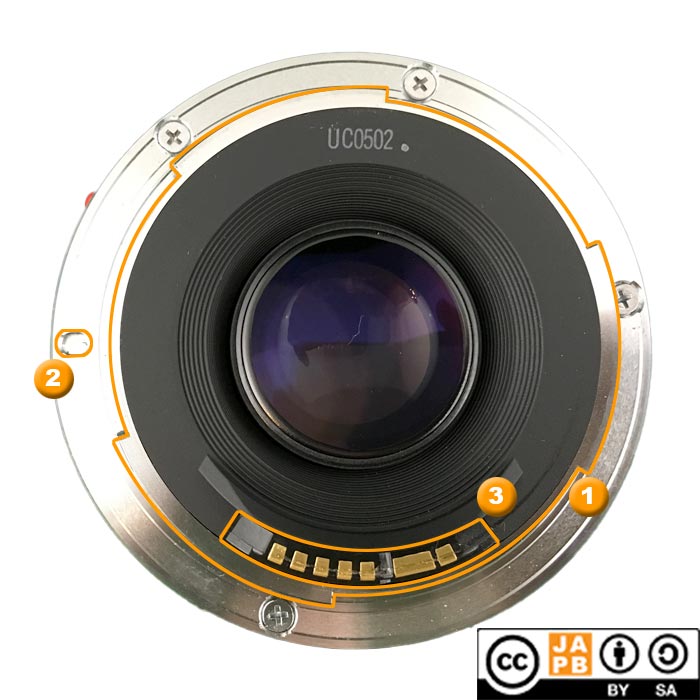Pekka Buttler (Updated 5/2025)
Basics of the EF mount (family)
As of 2025, the Canon EF mount is still a current mount, although Canon has already introduced a newer mount (the Canon RF mount). The Canon EOS-M cameras (EF-M-mount) were discontinued in 2022, but (as of 5/2025) Canon EF and EF-S series cameras are still being sold new (even though no new products have been introduced in ≈5 years).
As Canon’s main focus has shifted to its mirrorless mount (Canon RF), and as video cameras are also shifting away from the EF mount, the days of the EF -mount are numbered. However how big that number is is anyone’s guess.
Canon EF mount family specifications and identification
Mount type: Bayonet (lens release on body)
Flange focal distance:
EF & EF-S: 44 mm
EF-M: 18 mm
Film format/sensor size:
EF: 36mm x 24mm (‘Full frame’)
EF-S and EF-M: APS-C (22.7 mm x 15.1 mm; Crop factor: 1,6x)
Mount communication: 7 electronic contacts (spring-loaded at the camera-end) that handle all body-lens-body communication (focusing, aperture movement, lens information communication)

Key characteristics of the mount of Canon EF lenses:
[1] Locking groove at 09:00.
[2] Three unsymmetrical bayonet prongs, all with straight edges.
[3] 7 Electronic contacts between 05:00 and 07:00.
[4] Red ball for helping lens alignment at mounting (EF-S lenses have a small white square in a slightly different position)
[5] Metal lens mount (black plastic on some cheaper lenses)
The inscription at 12:00 is not a serial number, but can instead be used to identify manufacture location and date. This lens having been manufactured at Canon’s Utsunomiya (U) factory in may (05) 1988 (C). On more modern (starting 2008) lenses, the syntax of this code has changed (but its purpose remains). See more here.
The Canon EF Family tree
The Canon EF-mount is a family of mounts composed of:
• the original Canon EF (electronic focus) mount (starting 1987),
• the EF-S mount for crop-sensor dSLR’s (starting 2004) and
• the EF-M mount for the Canon EOS M-series mILC’s (Starting 2012).
All three have physically the same mount, but inter-system compatibility is limited.
EF and EF-S mounts have the same flange focal distance (44 mm), but EF-S lenses are designed with Canon’s APS-C sensors (22.7 mm x 15.1 mm; Crop factor: 1,6x) in mind, and do not cover a full-frame sensor.
EF-M lenses are designed for Canon’s EOS-M series of interchangeable lens mirrorless cameras, and while they use the same APS-C sensor (22.7 mm x 15.1 mm; Crop factor: 1,6x), the flange focal distance is significantly shorter (18 mm).
While EF-S and EF lenses can be used on EOS-M cameras using a suitable adapter (a smart adapter), EF-M lenses can not be used on EF or EF-S bodies.
Besides Canon, Canon EF lenses have been manufactured by a wide range of third-party lens manufacturers.
Adapting Canon EF (and EF-S) lenses:
With Canon EF (and EF-S) lenses having a flange focal distance of 44 mm, they can relatively easily be adapted to all mILC’s, with one proviso: As Canon EF lenses are fully electronically controlled, controlling the aperture of Canon EF lenses necessitates a smart adapter (A dumb adapter could be used to mount an EF lens at the correct distance, but the aperture would always remain wide open). Naturally Canon EF lenses can also be used on Canon R -mILC bodies with one of Canon’s own EF-to-RF adapters.
Adapting to Canon EF Family cameras:
There are two stories here: That of EF and EF-S cameras on the one hand (Flange focal distance 44 mm) and that of EF-M cameras (FFD: 18 mm) on the other.
EF and EF-S cameras (whether full frame or 1,6x crop) offer a relatively short flange focal distance for being a SLR/dSLR system. This means that a wide range of lenses can be adapted to Canon EF/EF-S cameras using a dumb adapter ring and an even wider range if you can consider an adapter with optics. However, especially on older EF/EF-S cameras (those that do not have live view) there are very few manual focusing aids available and even getting the ‘green dot’ focus confirmation necessitates an adapter that has a focus confirmation chip.
EF-M cameras are fundamentally crop-sensor mirrorless cameras, and carry all the (in terms of adapting legacy lenses) advantages of a mirrorless system, while also carrying the downside of being a crop sensor system, meaning a change in effective field-of-view. On the other hand, there are some speed boosters available that can help overcome this handicap.